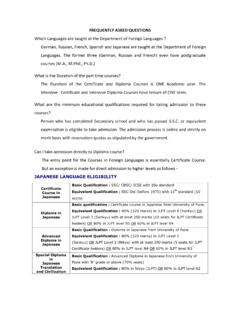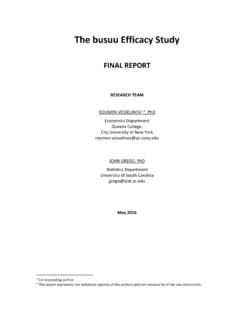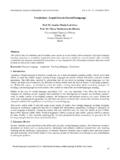Transcription of EN 12642-XL A Layman’s guide to the - Welcome to Don-Bur
1 +44(0)1782 599 666 | layman s guide to theEuropean load containment standardPublishedSeptember 2015EN 12642-XLContentsIntroduction ..What is EN 12642-XL ?..Static Test (Annex A)..Dynamic Test (Annex B)..Double Use Of Additional Load EN 12642-XL EN 12642-XL 12642-XL For Your IntroductionThis document is a diluted interpretation of the 28 page BS EN 12642:2006 (L & XL) standard, designed to enable a quicker and easier understanding of the content and its implications. The suitability of the standard or compliance with law or regulation is not covered direct references are taken from the original document, they are highlighted in blue italics and surrounded by inverted commas - this content.
2 Whilst the standard covers both the L (section ) and XL (section ) ratings within the EN 12642 documentation, this guide only serves to cover the more demanding and higher rated XL is EN 12642-XL ?EN 12642-XL is a whole-body, European load containment standard. Under strict conditions, a reinforced vehicle body (either trailer or rigid bodywork over 3,500kgs GVW) is tested by an accredited body such as the German TUV or the UK VCA. If the bodywork passes the tests , a certificate will be issued together with the right to apply a compliance mark to the bodywork to indicate that the vehicle complies with the 12642-XL is not necessarily a legal requirement in any EU member state.
3 In the UK, for example, EN 12642-XL is recognised as a contributory standard but is not, in itself, a legal requirement*. All individuals (consignor, operator or driver) responsible for load restraint are advised to seek further advice to determine the suitability and legal compliance of any load containment or load restraint 12642-XL can be applied to both box van and curtainsided 2 of 7*Accurate at time of 12642-XLYEAR OF MANUFACTURE - 2015 THIS VEHICLE BODY COMPLIES WITH THE STANDARDM anufactured by: Don-Bur (Bodies & Trailers) Ltd, Mossfield Road, Adderley Green, Longton,Stoke-on-Trent, Staffordshire ST3 5BW02020304050607070707 Page 3 of 7 The TestsThere are two distinct test methods, either of which can result in a pass certificate.
4 Both test methods are equally demanding although the equipment needed, forces and thresholds are is also possible to obtain a compliance certificate through calculation although this is not covered in this is P ?Although P is usually recognised as a unit of pressure, this unit is redefined in the standard as the weight force (in daN) of the vehicle to be tested at the authorised payload .This may be confusing as the tests are done with pressurised air bags. In reality, the testing agency calculates the required pressure (MPa) over the required curtain test area in order to achieve the required daN force.
5 The original full standard document covers this in more DaN is similar in unit quantity to 1 kg. 1 daN x 10 = 10N 10N / = kgs 1 daN = kgsStatic Test (Annex A)The static test, as the name suggests, is carried out while the vehicle is stationary. A framework, referred to as a reaction frame, is installed within the vehicle body and deflated air bags are positioned in the 50mm space between the reaction frame and the outer bodywork (front bulkhead, sides and rear). The air bags are then inflated by a compressor to a precalculated pressure threshold for a minimum of 5 minimum forces required ~For example, a curtainsided trailer with a maximum payload potential of 29 tonnes (29,000 kgs) will be tested as follows:Front Wall ~ 14,500 daN, Side Walls ~ 11,600 daN, Rear Wall ~ 8,700 daNApproval Criteria After finishing the tests , the body structure shall show neither permanentdeformation nor other changes which would impair its intended use.
6 1) elastic deformation occurring during the test shall not exceed 300 ) at a test force of 85 % of the 100 % to be used for testing there shall be no permanent ) at 100 % of the test force permanent deformation may at maximum be of 20 mm, however, aptitude for the intended function shall not be impaired. to front to rear to side wallWhat is a suitable load?The standard describes the load as cargo units which lose their stability under the effect of a transverse acceleration of 0,25g. Suitable cargo units shall be loaded uniformly over the entire length and width of the cargo area of the vehicle to be tested; the height of loading shall be > 1/2 x loading height and loading shall be up to the permitted total weight.
7 The TestsBrakingTransverseAccelerationChange OfLane TestReverse BrakingPage 4 of 7 Dynamic Test (Annex B)The dynamic test is usually carried out on a large tarmac asphalt area such as an airfield. A suitable load is placed on the bed of the vehicle and it is then driven through 4 manoeuvre types until the test criteria are manoeuvres impose G-forces on the intended minimum forces required ~A standard 44 tonne combination, for instance, should be loaded with the maximum payload potential (circa 29 tonnes).Approval CriteriaThe following criteria is specified for each and all of the 4 tests (as illustrated right).
8 The cargo securing equipment shall perform its function in three consecutive tests . If the cargo is secured by the vehicle body structure this means that there may be no permanent deformations or tears in the walls of the body or in their connections to the frames. If the cargo is secured by lashing equipment such equipment shall not display any damage. to front to rear to side wall On the top loading level at half the height of the body it is permitted to carry 50 % of the total payload. Where cargo loads on the upper deck depart from this or where the height position of the second cargo leveldiffers, the percentage portion changes accordingly.
9 Page 5 of 7 Double Decks (Section )Special provisions are laid out for double decks as the stresses imposed on the bodywork differ from single deck trailer or rigid minimum forces for both front bulkhead and rear wall are described on page 3. The minimum forces required for the side wall are as follows ~Box Van ConstructionCurtainsided ConstructionWhere the supporting cross beams are of a telescopic design (sometimes used in Europe with side pillars and cabbage board supports), an additional should be added to the side force requirement.
10 Dynamic testing can also be carried out to achieve similar to side to side wallMarkingCompliant bodywork should be marked as follows: a) confirmation that the vehicle body structure complies with this standard;b) reference to this European Standard, EN 12642;c) indication of the pertinent requirement profile -Codes, L ( ) or XL ( );d) name of manufacturer;e) year of production. Marking shall be by means of an independent sign. However, it shall also be integrated into the vehicle identification plate. In the latter case, points d) and e) need not be repeated.





